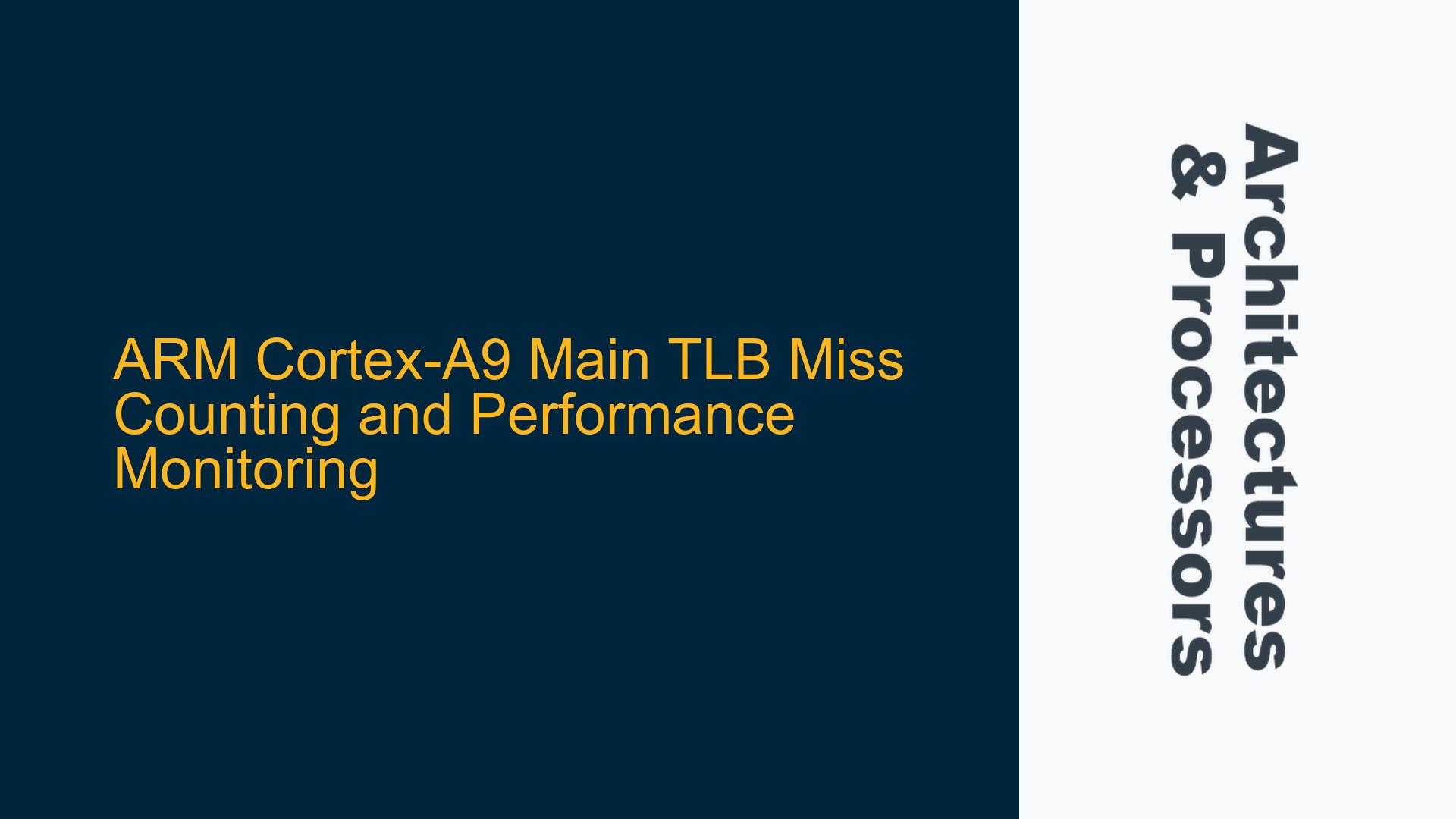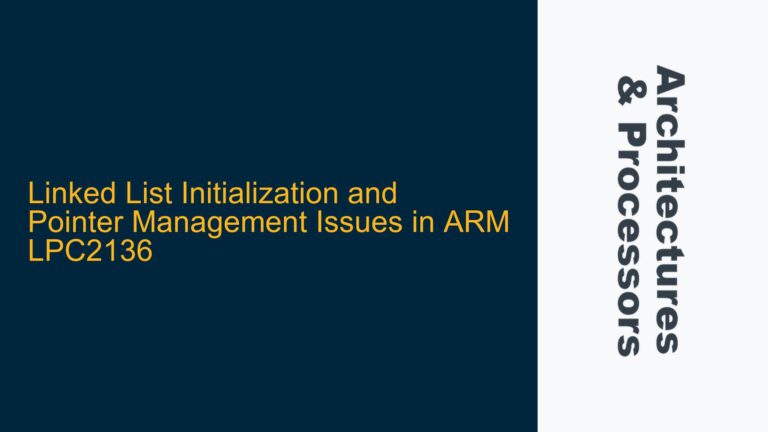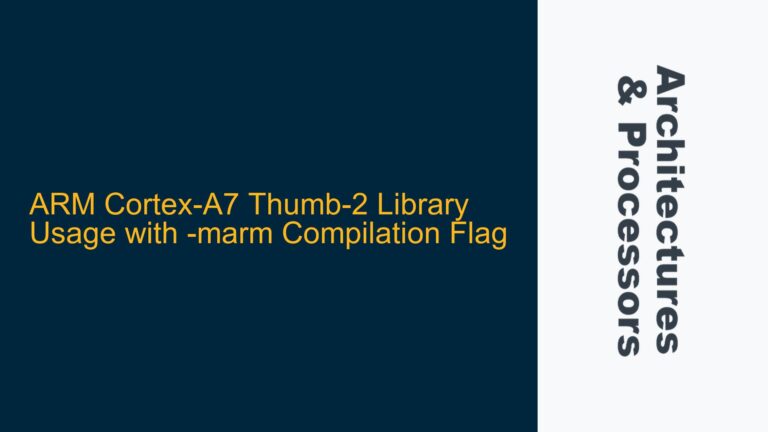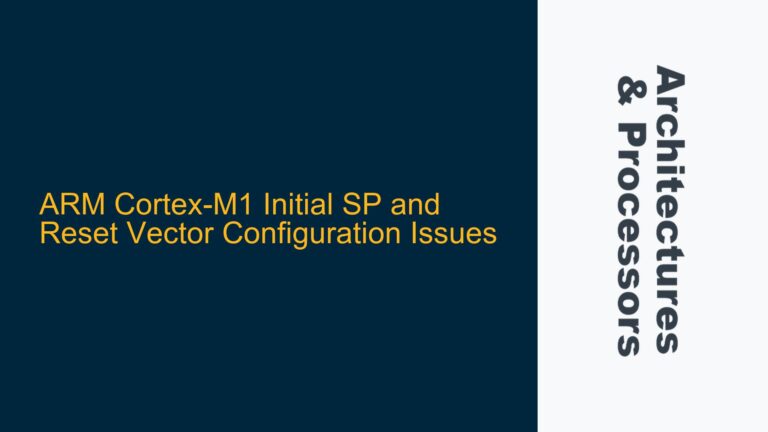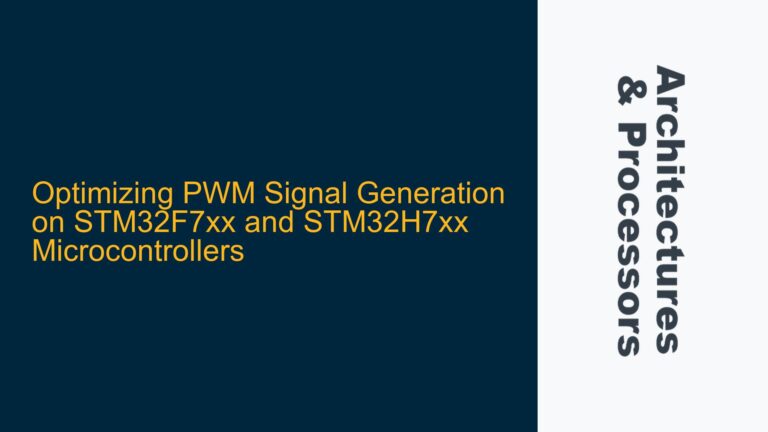ARM Cortex-A9 Main TLB Miss Counting Challenges
The ARM Cortex-A9 processor, a widely used core in embedded systems, employs a two-level Translation Lookaside Buffer (TLB) architecture to optimize virtual-to-physical address translation. The TLB hierarchy consists of micro TLBs (uTLBs) and a main TLB. While the uTLBs are small, fast caches for recently used translations, the main TLB serves as a larger, slower backup. When a translation is not found in the uTLBs (a uTLB miss), the processor checks the main TLB. If the translation is also absent in the main TLB (a main TLB miss), a hardware table walk is initiated to fetch the translation from memory. This process introduces significant latency, making main TLB misses a critical performance bottleneck.
Counting main TLB misses is essential for performance analysis and optimization, especially in systems with high memory access demands. However, the Cortex-A9’s Performance Monitoring Unit (PMU) does not natively support direct counting of main TLB misses. Instead, it provides events for uTLB misses, such as "Instruction micro TLB miss" and "Data micro TLB miss." This limitation poses a challenge for developers seeking to profile and optimize systems where main TLB misses are suspected to degrade performance.
The absence of a dedicated main TLB miss event in the PMU requires developers to infer main TLB miss counts indirectly. This involves correlating uTLB miss events with other performance metrics, such as cache misses and memory access patterns. Additionally, the operating system (OS) environment may provide tools or APIs to access low-level processor registers, enabling custom performance monitoring implementations. However, these approaches require a deep understanding of the Cortex-A9 architecture, PMU event configurations, and OS-level interactions.
PMU Event Limitations and Indirect Main TLB Miss Inference
The Cortex-A9 PMU supports a range of architectural and microarchitectural events, but its inability to directly count main TLB misses necessitates alternative methods for performance analysis. The PMU events related to TLB operations are primarily focused on uTLB misses, which occur when a translation is not found in the uTLBs. While uTLB misses are a subset of main TLB misses, they do not provide a complete picture of TLB performance.
To infer main TLB misses, developers can leverage the relationship between uTLB misses and main TLB misses. Specifically, a main TLB miss occurs only if a uTLB miss has already occurred. By monitoring uTLB miss events and analyzing the subsequent memory access behavior, it is possible to estimate the frequency of main TLB misses. This approach requires careful consideration of the system’s memory access patterns and the interaction between the TLB hierarchy and the memory subsystem.
Another factor complicating main TLB miss counting is the hardware table walk mechanism. When a main TLB miss occurs, the Cortex-A9 performs a hardware table walk to fetch the required translation from memory. This process involves accessing page tables stored in memory, which can introduce additional latency and cache misses. By monitoring cache miss events and correlating them with uTLB miss events, developers can gain insights into the occurrence of main TLB misses and their impact on system performance.
The OS environment also plays a crucial role in performance monitoring. Many operating systems provide APIs or tools to access low-level processor registers, including the PMU. These APIs can be used to configure and read PMU events, enabling custom performance monitoring implementations. However, the availability and functionality of these APIs vary across different OSes, and their use requires a thorough understanding of the underlying hardware and software interactions.
Implementing Custom Performance Monitoring for Main TLB Misses
To address the challenge of counting main TLB misses on the Cortex-A9, developers can implement custom performance monitoring solutions that combine PMU event monitoring with OS-level tools and APIs. The following steps outline a systematic approach to inferring main TLB miss counts and optimizing system performance:
-
Configure PMU Events for uTLB Misses: Begin by configuring the PMU to monitor uTLB miss events, such as "Instruction micro TLB miss" and "Data micro TLB miss." These events provide a baseline for understanding TLB performance and serve as the foundation for inferring main TLB misses.
-
Monitor Cache Miss Events: In addition to uTLB miss events, configure the PMU to monitor cache miss events, such as L1 and L2 cache misses. Cache misses can indicate memory access patterns that are likely to result in main TLB misses, providing additional context for performance analysis.
-
Analyze Memory Access Patterns: Use the data collected from PMU events to analyze the system’s memory access patterns. Look for correlations between uTLB misses, cache misses, and memory access latency. These correlations can help identify scenarios where main TLB misses are likely to occur.
-
Leverage OS-Level Tools and APIs: If available, use OS-level tools and APIs to access low-level processor registers and configure custom performance monitoring setups. These tools can provide additional insights into system behavior and enable more granular control over performance monitoring.
-
Implement Data Synchronization Barriers: Ensure that data synchronization barriers are used appropriately to maintain cache coherency and prevent inconsistencies in performance monitoring data. Data synchronization barriers are especially important in multi-core systems, where cache coherency issues can complicate performance analysis.
-
Validate and Refine the Monitoring Setup: Continuously validate the performance monitoring setup by comparing the inferred main TLB miss counts with observed system behavior. Refine the monitoring configuration as needed to improve accuracy and relevance.
-
Optimize System Performance: Use the insights gained from performance monitoring to optimize system performance. This may involve adjusting memory access patterns, modifying page table configurations, or implementing software optimizations to reduce the frequency of main TLB misses.
By following these steps, developers can effectively infer main TLB miss counts on the Cortex-A9 and gain valuable insights into system performance. While the absence of a dedicated main TLB miss event in the PMU presents a challenge, a combination of PMU event monitoring, cache miss analysis, and OS-level tools can provide a comprehensive understanding of TLB performance and guide optimization efforts.
Advanced Techniques for Main TLB Miss Analysis
For developers seeking to delve deeper into main TLB miss analysis, advanced techniques can provide additional insights and optimization opportunities. These techniques involve leveraging architectural features, custom hardware configurations, and sophisticated software tools to enhance performance monitoring and analysis.
-
Hardware Performance Counters: In addition to the PMU, the Cortex-A9 provides hardware performance counters that can be used to monitor a wide range of events. These counters can be configured to track specific events related to TLB operations, cache behavior, and memory access. By combining data from multiple counters, developers can build a more detailed picture of system performance and identify subtle performance bottlenecks.
-
Custom Hardware Configurations: In some cases, custom hardware configurations can be used to enhance performance monitoring capabilities. For example, developers can implement custom logic to track main TLB misses directly or use external performance monitoring tools to capture additional data. These configurations require a deep understanding of the hardware architecture and may involve significant development effort.
-
Software Profiling Tools: Software profiling tools can provide additional insights into system performance by analyzing the behavior of individual software components. These tools can help identify specific code paths or functions that contribute to high TLB miss rates, enabling targeted optimizations. Profiling tools can also be used to validate the accuracy of inferred main TLB miss counts and refine performance monitoring setups.
-
Simulation and Modeling: Simulation and modeling techniques can be used to predict the impact of different configurations and optimizations on TLB performance. By creating detailed models of the TLB hierarchy and memory subsystem, developers can explore the effects of various parameters and identify optimal configurations. Simulation can also be used to validate performance monitoring setups and guide optimization efforts.
-
Machine Learning and Data Analysis: Machine learning and data analysis techniques can be applied to performance monitoring data to identify patterns and correlations that may not be immediately apparent. These techniques can help uncover hidden performance bottlenecks and guide optimization efforts. Machine learning models can also be used to predict the impact of different optimizations and prioritize efforts based on potential performance gains.
By combining these advanced techniques with the foundational steps outlined earlier, developers can achieve a comprehensive understanding of main TLB miss behavior and implement effective optimizations to enhance system performance. While these techniques require additional expertise and effort, they offer the potential for significant performance improvements and a deeper understanding of the underlying hardware-software interactions.
Conclusion
Counting main TLB misses on the ARM Cortex-A9 processor presents a unique challenge due to the lack of a dedicated PMU event for this purpose. However, by leveraging uTLB miss events, cache miss analysis, and OS-level tools, developers can infer main TLB miss counts and gain valuable insights into system performance. Advanced techniques, such as hardware performance counters, custom hardware configurations, and software profiling tools, can further enhance performance monitoring and optimization efforts.
Understanding and optimizing TLB performance is critical for achieving high performance in embedded systems, especially in applications with demanding memory access patterns. By systematically analyzing TLB behavior and implementing targeted optimizations, developers can reduce latency, improve throughput, and enhance overall system efficiency. The Cortex-A9’s robust architecture and flexible performance monitoring capabilities provide a solid foundation for these efforts, enabling developers to unlock the full potential of their systems.
